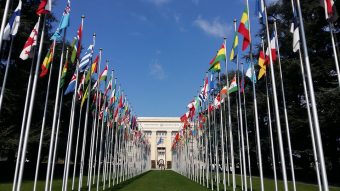Mother Earth got a bad health report from the United Nations this week, and the scientific team that conducted the exam didn’t shirk from delivering the bad news. The word “dire” comes to mind.

The assessment is contained in the sixth Global Environmental Outlook, a 708-page compendium of the planet’s ailments that was released at a U.N. environmental conference here this week. The Earth’s condition has continued to deteriorate since the first global outlook was prepared in 1997 and “urgent action at an unprecedented scale necessary to arrest and reverse this situation,” the team warned.
“The science is clear,” Joyce Msuya, acting executive director of U.N. Environment, said in a briefing. “The health and prosperity of humanity is directly tied with the state of our environment.”
She added the planet stands at a crossroads: the Earth’s ailments are treatable, but not for a lot longer if people don’t make fundamental changes in what they consume, how they create energy, dispose of waste, and generally decrease the human footprint that is degrading air, water, and land. Does the Earth pivot toward a sustainable future, she asks, or continue along its current path, leading, she warns, to a “bleak future.”
“This report is an outlook for humanity,” she said.
The document, named “Our Planet: Healthy Planet, Healthy People,” serves as a companion manual to the U.N.’s regular climate change publications. It’s impact is not that these threats are new discoveries, but that they’re assembled together in a collection that is profoundly dismaying.
“Time is running out to prevent the irreversible and dangerous impacts of climate change,” the report says, warning that the world is “on course to exceed the temperature threshold” of warming, meaning another 1.8 degrees Fahrenheit (1 degree Celsius) above that set out in the Paris climate agreement.
Serious threats
Overall, the Earth suffers from land degradation; biodiversity loss; air, land and water pollution; and the effects of climate change—and must prevent and manage further risks and disasters. Without changes, the situation looks bleak for all of its inhabitants. A major extinction event is underway, compromising the globe’s “ability to meet human needs,” the report warns.
Biodiversity helps regulate climate, filters air and water, forms soil, and mitigates the effects of natural disasters, the team explains. Yet, populations of species are declining and extinction rates are rising. Presently, 42 percent of land-based invertebrates, 34 percent of freshwater invertebrates, and 25 percent of marine invertebrates are at risk for extinction. Biodiversity disproportionately affects women, children, and the poor. The livelihoods of 70 percent depend directly on natural resources.
Human populations suffer from the reverse. The population is on track to reach nearly 10 billion by 2050. Without “profound and urgent” changes in production and consumption patterns, that population growth will continue and the planet will not be able to support it in a healthy, productive, and fulfilled way by mid-century. Ninety percent of that growth will take place in Africa and Asia. Almost all coastal cities of any size are vulnerable to sea-level rise and flooding caused by extreme weather events.
As for the Earth itself, 10 out of 14 land habitats have seen a decrease in vegetation productivity. Forty percent of wetlands have been lost to agriculture and urban development since 1970. Farm land is becoming less fertile and useful, due in part to inefficient and unsustainable farming systems. Degraded “hot spots,” no longer able to easily grow crops, now account for 29 percent of all land areas. Deforestation has slowed, but continues. Genetic diversity is in decline, threatening food security.
In most regions, water quality has worsened “significantly” since 1990, poisoned by chemical pollution. One in three people still lacks access to safe sanitation.
Pointing to solutions
The report also prescribes multiple methods for healing the globe, many of them by using methods and technologies that already exist. To cite one, biodiversity loss and land degradation can be stopped, the authors argue, by changes in consumption, agricultural practices, and redistribution of food. Meeting carbon reduction goals also will reduce air pollution, which now prematurely kills between six and seven million people a year.
Joyeeta Gupta and Paul Ekins, who oversaw the preparation of the report, said in a statement that the world has the capability to reset a sustainable course. What’s missing, they said, is the political will to act, speed, and scale.
Author: Laura Parker
Source: National Geographic

